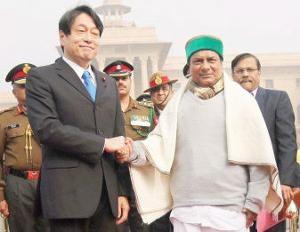August 28, 2013
MUMBAI: The rupee on Wednesday collapsed to a lifetime low of 68.85 against the dollar and closed at 68.80, registering its biggest single-day loss of 256 paise, as global oil prices jumped, deepening concerns about the current account deficit and capital outflows.

August 28, 2013
MUMBAI: The rupee on Wednesday collapsed to a lifetime low of 68.85 against the dollar and closed at 68.80, registering its biggest single-day loss of 256 paise, as global oil prices jumped, deepening concerns about the current account deficit and capital outflows.

Consistent dollar demand from banks and importers, mainly oil refiners, following higher crude oil prices, kept the rupee under pressure.
At the interbank foreign exchange market, the rupee opened at 66.90 a dollar against 66.24 previously and dropped to 68.75 in late morning deals. It recovered some ground in the afternoon after the central bank was said to have intervened but dropped to an all-time intra-day low of 68.85 before ending at 68.80, a fall of 256 paise or 3.86 per cent.
In three trading days in a row, the rupee has lost 560 paise, or 8.86 per cent, against the dollar. So far in August, it has tanked by 840 paise, or about 14 per cent, and in the current year by 1,381 paise or over 25 per cent.
"There is a shortage of dollars in the market as participants are expecting the rupee to fall to 70-72 level," said Naveen Raghuvanshi, associate vice-president at Development Credit Bank. "Even corporates are not willing to sell dollars at these levels. Whatever small supply of dollars is seen today (Wednesday), it is coming from the nationalized banks."
Oil prices climbed on fears a military strike against Syria for alleged use of chemical weapons against civilians would disrupt crude supplies from West Asia. Higher oil prices and a declining rupee are a double whammy for India, which imports 80 per cent of its crude needs.
The dollar strengthened overseas on likely tapering of bond buying by the US Federal Reserve from next month, putting pressure on the rupee. Sentiment was also hurt by increased capital outflows and fears of a rising subsidy burden with the passage of the Food Security Bill.
The benchmark S&P sensex, which was down by 519 points in late morning deals, recovered and closed up by 28 points.
The finance ministry described Wednesday's sharp fall in the rupee value as a reflection of "irrational sentiment" and said there is no need to panic.
As the rupee continued its free fall against the dollar, cars, TVs, washing machines and other home appliances are set to cost more, with companies set to hike prices to offset the impact on their margins.
Brent oil prices climbed to as much as $117.34 a barrel in London.
The dollar index was up by 0.30 per cent against its major global rivals.
Foreign institutional investors continued their selling spree and withdrew a net Rs 1,120.43 crore of stocks on Wednesday, as per provisional data with the stock exchanges.
"Foreign investors sold $1 billion of equities in the past eight days," said Pramit Brahmbhatt, CEO of Alpari Financial Services (India). "Dollar demand from oil importers as well as foreign investors will force the rupee to trade towards 70 levels in coming days."
Forward dollar premiums remained firm on continued payments from banks and corporates.
The benchmark six-month forward dollar premium payable in January hardened to 246-1/2-250-1/2 paise from 238-1/2-243-1/2 paise previously. Far-forward contracts maturing in July rose further to 465-470 paise from 459-464 paise.
The RBI fixed the reference rate for the dollar at 68.3611 and for the euro at 91.4682.
The rupee tanked further to 106.33 against the pound sterling from 102.80 earlier and nose-dived against the Japanese yen to 70.64 per 100 yen from 67.76. It stumbled to 91.85 per euro from 88.36.
Courtesy: PTI
















































































































